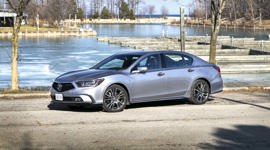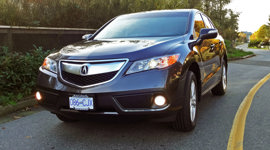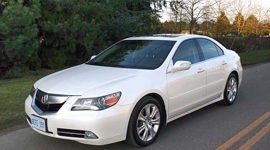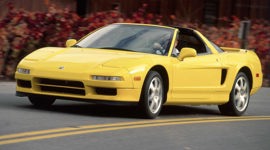Collingwood, Ont. – It had been almost exactly a year since I last drove the Acura RLX – the flagship in Honda’s upscale brand – and in getting back into the car you see featured here, I was quickly refreshed on the fleeting impressions it had made on me.
First off, it’s a handsome car, if somewhat forgettable save for the multi-lens LED headlights. In person, it commands more respect than it does in photos thanks to its solid proportions and imposing scale, letting observers know that this is no entry-level sedan.
Inside, one is reminded of an oversized Accord that has spent a few more classes in finishing school.
The materials are all luxurious and supple where they need to be, with the appropriate applications of high-grade trim where warranted for visual appeal. The overall effect is lacking some of the artful design emerging in many of the best of the class competitors. The Krell sound system remains one of the highlights of the car with its sensational power and sound quality.
All of that applies to the front-wheel-drive RLX Elite that I drove last year with its P-AWS (active all-wheel steering) and its front-wheel drive, just as much as it applies to the new offering we’re examining here.
Befitting its place in the mid-size luxury sedan class, Acura Canada is now offering a version of the RLX with its SH-AWD (Super-Handling All-Wheel Drive) system. Canadian luxury car buyers have shown with their cheque books that it is their overwhelming preference to have four wheels dispensing the power rather than just two, so this move was an absolute necessity for Acura to be taken seriously in this segment.
But this is not like Acura’s usual SH-AWD system. This time, the rear wheels are motivated solely by electric power, as the RLX presents the first application of the new Sport Hybrid system.
In what is a world first, Acura has incorporated a three-motor hybrid system. The first motor is integrated into the seven-speed DCT transmission. It’s a low-speed unit that essentially replaces first gear. It provides up to 109 lb-ft of torque between 500-2,000 rpm and aids the gasoline engine powering the front wheels up to speed from a standstill.
The 3.5L direct-injected V6 is essentially carryover from the FWD RLX, providing the same 310-hp output and 273 lb-ft of torque. Vibrations have now been quelled in this 2015 car, with a camshaft valve timing change, for those keeping track of the minutiae.
Where things really get interesting, is toward the back of the car with a pair of higher-speed smaller motors each directing up to 54 lb-ft of torque to a single rear wheel. This Twin Motor Unit (TMU) enables a host of benefits including improved acceleration, efficiency and even handling.
All of this hardware, in addition to the Power Drive Unit (the same battery pack used in the Accord Hybrid) adds 110 kg of mass to the RLX versus the front-drive version. While additional weight automatically equates to worse performance in most cars, here all is not lost.
For one thing, most of the extra mass is clustered around the rear axle, meaning it’s both low in the car, and moved rearward. This translates to a centre of gravity that is not adversely affected, and in fact the fore-aft weight distribution is better balanced on the heavier Hybrid car. Plus the combined drivetrain now peaks at 377 horsepower and 341 lb-ft of torque – considerable improvements versus the non-hybrid RLX.
Much more importantly, the rear Twin Motor Unit has a few tricks up its sleeve to make the RLX Sport Hybrid a more dynamic performance machine. By having two independent motors driving the rear wheels, torque vectoring can dramatically assist the handling. The TMU can generate a yaw moment in the vehicle, essentially rotating it on an axis thanks to positive torque being directed to the outer wheel, while negative torque is applied to the inner wheel. Even in gentle, off-throttle cornering, this benefit can still assist the dynamics of the car.
The benefits of the TMU are much greater than just torque vectoring. Traction for acceleration is obviously improved versus the FWD RLX, but like most hybrid systems, the improvement to fuel efficiency is also significant.
Here Acura has set up seven different drive modes to optimally suit the different types of motoring circumstances a driver could encounter. In EV mode, the rear TMU will launch the car under light acceleration and maintain it under light power – in stop and go traffic, for instance. Under normal, gentle acceleration, the engine and front motor will pull the car along. At high speed cruising, the engine will also be called on to keep the car rolling.
Under heavy acceleration and in slippery conditions, all systems are called to action, ensuring the power is delivered to the appropriate wheels. During deceleration, regeneration occurs to front and rear motors.
The infotainment system and standard Head-Up Display feature graphics that can help show curious drivers in real-time how all the power is being dispensed around the car. The computers will also tell you how efficient the RLX Sport Hybrid is, too. The government five-cycle rating system estimates the RLX Sport Hybrid at 8 L/100 km city, 7.5 highway and 7.7 combined – excellent figures for such a large, capable and luxurious sedan.
One additional benefit to the rear TMU set up: unlike in a traditional rear- or all-wheel-drive car, there’s no prop shaft in the RLX, resulting in virtually no “centre hump” intrusion to the passenger compartment, helping the RLX maintain its best-in-class rear seat space. Plus, power travelling down a prop shaft creates a slight delay in throttle response. With the instantaneous nature of the electric motors, Acura claims a livelier feel and higher level of throttle responsiveness.
The RLX Sport Hybrid SH-AWD is an unquestionable technological tour de force, but how does it all translate to a real-world driving experience?
Very well, actually. Driven around Collingwood, Ontario, the RLX hybrid is smooth, quiet and refined, just as it should be in this class of luxury cars. Despite being a very large car, it does not embarrass itself when the roads begin to curve.
Although our drive was relatively brief – only a few hours – I would rather press the RLX Sport Hybrid on roads more familiar to me to really assess the effectiveness of the torque vectoring. Most buyers in this category will surely feel the RLX Sport Hybrid delivers performance on par or superior to the competitors without ever really needing to push the car anywhere near its limits.
Passing power and responsiveness is formidable and even the regenerative braking is far less grabby and artificial-feeling than in most other hybrids. The seven-speed DCT transmission will give fun throttle blips before downshifting when Sport mode is engaged. While reasonably rapid, the shifts called upon by the steering wheel mounted paddles were not as lighting-fast or crisp as the shifts executed by some of the competitors’ gearboxes – especially those using the excellent ZF eight-speed transmission.
Acura’s previous flagship – the RL – was as memorable as a stale soda cracker. As a result, Acura needs to work extra hard to lure away buyers of competitive models, and they seem to be serious about it this time. The RLX Sport Hybrid is an excellent offering in a stellar group of competitors, but it also represents one of the best values. Offered only in full Elite trim, the $69,990 RLX Sport Hybrid SH-AWD undercuts similarly equipped competitors from Lexus, BMW and Mercedes-Benz by anywhere from $5,000 – $10,000. Infiniti’s Q70h skirts under the RLX by a little more than $1,000, but does not offer all-wheel drive.
For buyers intrigued by the latest technological fads, Acura’s offering in the mid-size luxury sedan market puts its high tech to great use, while providing a luxurious and engaging driving experience.
Pricing: 2015 Acura RLX Sport Hybrid SH AWD
Base Price: $69,990
















